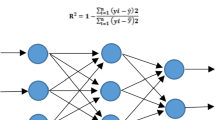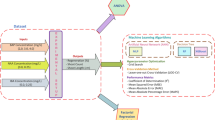Abstract
Optimization of in vitro regeneration protocol using multiple input variables is highly significant, and can be achieved by validating the data using machine learning algorithms. Shoot tip and nodal segment explants of Alternanthera reineckii mini were inoculated on Murashige and Skoog (MS) medium enriched with different concentrations of benzylaminopurine (BAP), and cultured under five different monochromic light-emitting diodes (LEDs). The attained results were validated through the application of four different supervised machine learning models (RF, XGBoost, KNN, and GP). The prediction of the data were validated by using regression coefficient (R2), mean squared error (MSE), and mean absolute percentage error (MAPE) performance metrics. Results revealed R2 values of 0.61 and 0.59 for shoot counts and shoot length, respectively. The results of MSE were registered between 3.48–5.42 for shoot count and 0.40–0.74 for shoot length, whereas, 28.9–35.1% and 13.2–18.4% MAPE values were recorded for both shoot count and shoot length. Among the utilized models, the RF model validated and predicted the results more accurately, followed by the XGBoost model for both output variables. The results confirm that ML models can be used for data validation, and opens a new era of employing ML modeling in plant tissue culture of other economically important plants.
Graphical abstract
Schematic structure presenting input features and outputs together with ML models, used validation and performance metrics





Similar content being viewed by others
Data availability
The whole datasets generated and/or analyzed during the current study are available from the corresponding author upon reasonable and acceptable request.
References
Aasim M, Bakhsh A, Sameeullah M, et al (2018a) Aquatic plants as human food. In: Global perspectives on underutilized crops. Springer, pp 165–187
Aasim M, Karatas M, Bakirci S, Sevinc C (2018b) In vıtro adventıtous shoot regeneratıon of water hyssop (Bacopa monnıerı L. PENNEL) under lıght emıttıng dıodes (LEDS). J Glob Innov Agric Soc Sci 6:129–133
Aasim M, Katırcı R, Akgur O et al (2022b) Machine learning (ML) algorithms and artificial neural network for optimizing in vitro germination and growth indices of industrial hemp (Cannabis sativa L.). Ind Crops Prod 181:114801
Aasim M, Katirci R, Baloch F, et al (2022a) Innovation in the breeding of common bean through a combined approach of in vitro regeneration and machine learning algorithms. Front Genet 13:
Aasim M, Khawar KM, Ahmed SI, Karataş M (2019) Multiple uses of some important aquatic and semiaquatic medicinal plants. In: Plant and human health, Volume 2. Springer, pp 541–577
Aasim M, Özcan SF, Khawar KM, Özcan S (2012) Comparative studies on the competence of axillary shoot regeneration on unsliced and longitudinally sliced cotyledon nodes of vigna unguiculata. Turk J Botany 36https://doi.org/10.3906/bot-1101-38
Aggarwal CC (2018) Neural networks and deep learning
Al-Tanbouz R, Abu-Qaoud H (2016) In vitro regeneration of chickpea (Cicer arietinum L.). Plant Cell Biotechnol Mol Biol 17:
Ayuso M, García-Pérez P, Ramil-Rego P et al (2019) In vitro culture of the endangered plant Eryngium viviparum as dual strategy for its ex situ conservation and source of bioactive compounds. Plant Cell, Tissue Organ Cult 138:427–435
Bello-Bello JJ, Martínez-Estrada E, Caamal-Velázquez JH, Morales-Ramos V (2016) Effect of LED light quality on in vitro shoot proliferation and growth of vanilla (Vanilla planifolia Andrews). African J Biotechnol 15:272–277
Breiman L (2001) Random forests. Mach Learn 45:5–32
Chang HS, Charkabarty D, Hahn EJ, Paek KY (2003) Micropropagation of calla lily (Zantedeschia albomaculata) via in vitro shoot tip proliferation. Vitr Cell Dev Biol 39:129–134
Chen T, Guestrin C (2016) XGBoost. In: Proceedings of the 22nd ACM SIGKDD International Conference on Knowledge Discovery and Data Mining. ACM, New York, NY, USA, pp 785–794
Dogan M (2018) In vitro shoot regeneration of Limnophila aromatica (Lamk.) Merr. from nodal and internodal explants. Iğdır Univ J Inst Sci Tech 8:77–84
Doğan M (2019) In vitro rapid propagation of an aquatic plant Pogostemon erectus (Dalzell) Kuntze. Anatol J Bot 3:1–6
Dogan M (2020) The effectiveness of light emitting diodes on shoot regeneration in vitro from shoot tip tissues of Limnophila aromatica (Lamk.) Merr. and Rotala rotundifolia (Buch-Ham. ex Roxb) Koehne. Biotech Histochem 95:225–232
Dogan M, Karatas M, Aasim M (2016) In vitro shoot regeneration from shoot tip and nodal segment explants of Pogostemon erectus (Dalzell) Kuntze, a multipurpose ornamental aquatic plant. Fresenius Environ Bull 25:4777–4782
Farhadi S, Salehi M, Moieni A et al (2020) Modeling of paclitaxel biosynthesis elicitation in Corylus avellana cell culture using adaptive neuro-fuzzy inference system-genetic algorithm (ANFIS-GA) and multiple regression methods. PLoS ONE 15:1–16. https://doi.org/10.1371/journal.pone.0237478
Gonsalves J (2010) Economic botany and ethnobotany. Mittal Publications
Hesami M, Jones AMP (2021) Modeling and optimizing callus growth and development in Cannabis sativa using random forest and support vector machine in combination with a genetic algorithm. Appl Microbiol Biotechnol 1–12
Hesami M, Naderi R, Tohidfar M (2019) Modeling and optimizing In vitro sterilization of chrysanthemum via multilayer perceptron-non-dominated sorting genetic algorithm-II (MLP-NSGAII). Front Plant Sci 10:1–13. https://doi.org/10.3389/fpls.2019.00282
Hesami M, Naderi R, Tohidfar M, Yoosefzadeh-Najafabadi M (2020) Development of support vector machine-based model and comparative analysis with artificial neural network for modeling the plant tissue culture procedures: effect of plant growth regulators on somatic embryogenesis of chrysanthemum, as a case study. Plant Methods 16:1–15
Hesami M, Pepe M, Monthony AS et al (2021) Modeling and optimizing in vitro seed germination of industrial hemp (Cannabis sativa L). Ind Crops Prod 170:113753. https://doi.org/10.1016/j.indcrop.2021.113753
Hu J, Sun Y, Li G et al (2019) Probability analysis for grasp planning facing the field of medical robotics. Meas J Int Meas Confed 141:227–234. https://doi.org/10.1016/j.measurement.2019.03.010
Jafari M, Shahsavar A (2020) The application of artificial neural networks in modeling and predicting the effects of melatonin on morphological responses of citrus to drought stress. PLoS ONE 15:e0240427
Jamshidi S, Yadollahi A, Arab MM et al (2020) High throughput mathematical modeling and multi-objective evolutionary algorithms for plant tissue culture media formulation: case study of pear rootstocks. PLoS ONE 15:e0243940
Karatas M, Aasim M, Dogan M (2014) Multiple shoot regeneration of Ceratophyllum demersum L. on agar solidified and liquid mediums. Fresenius Environ Bull 23:
Karataş M, Aasim M, Dazkirli M (2016) Influence of light-emitting diodes and benzylaminopurin on adventitious shoot regeneration of water hyssop (bacopa monnieri (L.) Pennell) in vitro. Arch Biol Sci 68:. https://doi.org/10.2298/ABS150803039K
Karataş M, Aasim M, Dazkirili M (2018) Efficacy of light emitting diodes (LEDs) lighting system for in vitro shoot regeneration of medicinal water hyssop (Bacopa monnieri L PENNEL). Rom Biotechnol Lett 23:13197
Katirci R, Aktas H, Zontul M (2021) The prediction of the ZnNi thickness and Ni % of ZnNi alloy electroplating using a machine learning method. Trans Inst Met Finish 99:162–168. https://doi.org/10.1080/00202967.2021.1898183
Kirtis A, Aasim M, Katırcı R (2022) Application of artificial neural network and machine learning algorithms for modeling the in vitro regeneration of chickpea (Cicer arietinum L.). Plant Cell, Tissue Organ Cult 1–12
Kul M, Oskay KO, Erden F et al (2020) Effect of process parameters on the electrodeposition of zinc on 1010 steel: central composite design optimization. Int J Electrochem Sci 15:9779–9795
Lewis CD (1982) Industrial and business forecasting methods: a practical guide to exponential smoothing and curve fitting. Butterworth-Heinemann
Li H, Xu Z, Tang C (2010) Effect of light-emitting diodes on growth and morphogenesis of upland cotton (Gossypium hirsutum L.) plantlets in vitro. Plant Cell, Tissue Organ Cult 103:155–163
Lian M-L, Murthy HN, Paek K-Y (2002) Effects of light emitting diodes (LEDs) on the in vitro induction and growth of bulblets of Lilium oriental hybrid ‘Pesaro.’ Sci Hortic (amsterdam) 94:365–370
Pavlov YL (2019) Random forests. Random For 1–122https://doi.org/10.1201/9780429469275-8
Pedregosa F, Varoquaux G, Gramfort A et al (2011) Scikit-learn: machine learning in {P}ython. J Mach Learn Res 12:2825–2830
Prasad VSS, Gupta SD (2008) Applications and potentials of artificial neural networks in plant tissue culture. In: Plant tissue culture engineering. Springer, pp 47–67
Ramazan K, Esma S, Belkıs U (2015) Statistical optimisation of organic additives for maximum brightness and brightener analysis in a nickel electroplating bath. Trans IMF 93:89–96
Rocha PSG, Oliveira RP, Scivittaro WB, Saints UL (2010) Diodes emitting light and BAP concentrations in the multiplication in vitro of strawberry. Cienc Rural St Maria 40:1922–1928
Saini DC, Singh SK, Rai K, Singh SK (2010) Biodiversity of aquatic and semi-aquatic plants of Uttar Pradesh:(with special reference to eastern Uttar Pradesh). Uttar Pradesh State Biodiversity Board
Salehi M, Farhadi S, Moieni A et al (2020) Mathematical modeling of growth and paclitaxel biosynthesis in Corylus avellana cell culture responding to fungal elicitors using multilayer perceptron-genetic algorithm. Front Plant Sci 11:1–12. https://doi.org/10.3389/fpls.2020.01148
Salehi M, Farhadi S, Moieni A et al (2021) A hybrid model based on general regression neural network and fruit fly optimization algorithm for forecasting and optimizing paclitaxel biosynthesis in Corylus avellana cell culture. Plant Methods 17:1–13
Sharma A, Jain A, Gupta P, Chowdary V (2020) Machine learning applications for precision agriculture: a comprehensive review. IEEE Access 9:4843–4873
Sotthikul C, Kaewpoowat C, Saimoon N (2015) In vitro propagation of Habenaria hybrids. In: VI International Symposium on Production and Establishment of Micropropagated Plants 1155. pp 293–300
Stirk WA, van Staden J, Novák O et al (2011) Changes in endogenous cytokinin concentrations in chlorella (chlorophyceae) in relation to light and the cell cycle 1. J Phycol 47:291–301
Sugimoto K, Temman H, Kadokura S, Matsunaga S (2019) To regenerate or not to regenerate: factors that drive plant regeneration. Curr Opin Plant Biol 47:138–150
Van Rossum G, Drake FL (2009) Python 3 reference manual. CreateSpace, Scotts Valley, CA
Webb GI, Sammut C, Perlich C et al (2011) Leave-one-out cross-validation. Encyclopedia of machine learning. Springer, US, Boston, MA, pp 600–601
Yoosefzadeh-Najafabadi M, Earl HJ, Tulpan D et al (2021a) Application of machine learning algorithms in plant breeding: predicting yield from hyperspectral reflectance in soybean. Front Plant Sci 11:2169
Yoosefzadeh-Najafabadi M, Tulpan D, Eskandari M (2021b) Application of machine learning and genetic optimization algorithms for modeling and optimizing soybean yield using its component traits. PLoS ONE 16:e0250665
Author information
Authors and Affiliations
Contributions
MA: conceived the idea and designed the research, data analysis, and article writing; SAA: performed machine learning modeling and article writing; PB: conducted research and data tabulation; MAA: data analysis and article writing.
Corresponding author
Ethics declarations
Conflict of interest
Not applicable.
Additional information
Publisher’s note
Springer Nature remains neutral with regard to jurisdictional claims in published maps and institutional affiliations.
Supplementary information
Below is the link to the electronic supplementary material.
Rights and permissions
Springer Nature or its licensor (e.g. a society or other partner) holds exclusive rights to this article under a publishing agreement with the author(s) or other rightsholder(s); author self-archiving of the accepted manuscript version of this article is solely governed by the terms of such publishing agreement and applicable law.
About this article
Cite this article
Aasim, M., Ali, S.A., Bekiş, P. et al. Light-emitting diodes induced in vitro regeneration of Alternanthera reineckii mini and validation via machine learning algorithms. In Vitro Cell.Dev.Biol.-Plant 58, 816–825 (2022). https://doi.org/10.1007/s11627-022-10312-6
Received:
Accepted:
Published:
Issue Date:
DOI: https://doi.org/10.1007/s11627-022-10312-6




